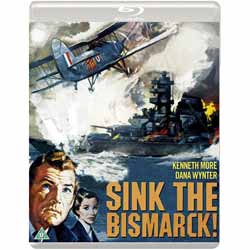|
Click here to return to the main site. Blu-ray Review
Debuting on Blu-ray, director Lewis Gilbert helms what is agreed to be one of the best of the British World War II sea hero stories of the time. These films, more than a dozen of them, have in more modern times been judged as quaint and historically sentimental. To the generations who lived, loved and lost in that conflict, they are cinematic hymns often drawing silent stifled feelings and catalysing lectures on the horrors and sacrifices that came in the skies over domestic life and duels in the Atlantic off the coast. Inevitably we will be told that these movies don’t begin to convey the consuming dread and desperate all-or-nothing struggle. Only so much can be shown on film, even the contemporary Dunkirk (2017) for all its raw realism, has been faulted as incomplete in showing how bad those bad days really were. By 1960 the decade of sea hero stories was coming to its end. These movies didn’t seem as much at home in the '60s. In 1958 and ‘59 it was decided to do the flagship version of this genre and what better true-life adventure than the greatest sea duel of them all: the sinking of Hitler’s unsinkable killing Atlantic machine, the Bismarck? The huge battleship was so well armoured, it was deemed impervious to torpedo and artillery. It was armed with such heavy guns it could not so much sink other ships as obliterate them, as indeed it did to the HMS Hood, when fifteen hundred crew members were incinerated and only three survived. The redoubtable C. S. Forester was employed to write a script. It was deemed too dry and prosaic so Edmund North (The Day the Earth Stood Still [1951] and later, Patton [1970]) was designated to work from the Forrester material. Forrester turned his script into a best-selling book and North’s screenplay is based on that. A fictional operation commander is created, Capt. Jonathan Shepherd, with a disclaimer at the end that he is no way intended to represent the real-life man who did the real-life job. Kenneth More is Shepherd, stern, buttoned up, feelings locked inside. This is apparent to us and his WRN Second Officer Anne Davis, Dana Wynter, who with over forty years in Hollywood television would occasionally bring her lustrous beauty to film (Invasion of the Body Snatchers [1955] Something of Value [1957] The List of Adrian Messenger [1963]). Maybe she was the poor man’s Barbara Rush. I’ve always liked her more than Rush and that’s saying a lot. It was novel for audiences to see More, known for his light-hearted comedies, to be driven by suppressed grief and Wynter is the ideal work companion who wants to set him free. The chemistry is believable and eminently watchable after all these years. The challenge to the narrative is that the three storylines never meet face to face. As film historian Sheldon Hall points out in the thoroughgoing Eureka Extras interview, it is an abstract conflict, a chess game where the players do not see each other. Shepherd knows his nemesis aboard the Bismarck, Admiral Günther Lutjens (Karl Stepanek) and he knows the captains of the eight Crown ships who assault the behemoth. When the Hood is lost it is gut wrenching and More’s grief is too deep for him to talk about. It is here that More connected with his War II veteran and domestic audiences. Every war veteran family saw in their own veteran, now home and ‘safe’ but unable or unwilling express the pain he had borne, the friends he had lost, the human destruction he had experienced. It was not only security oaths which prohibited these conversations but the abhorrence of a loss of control. The fear of uncontrollable tears. The drama between More and Wynter is an idealized transaction of what every veteran, man or woman, should have had but often did not. The movie is trying to fill this gap. As Shepherd plots his table top war, we cross cut to the roaming sea battle itself. On the bridges of the war ships we follow the British and German cohorts. The external battle scenes are almost completely miniature shots of large-scale models in the giant Pinewood pools. These are some of the most cunning examples of miniature art direction in all of film. With no CGI in anyone’s dreams, everything had to be practical. The monarch of miniatures in all film history, Howard Lydecker, (champion effects artist from the late Republic Studios, especially the serial department) was brought in to supervise and advise the exemplary Pinewood team. It wasn’t just the ships but the management of the water. Lydecker’s mini-Atlantic rolls and heaves and is adorned with surface corrugations that, while apparent for what they are, are nevertheless charming and if I may pull out a word from my ancient childhood days, "neat". Christopher Challis’s cinematography is of that stable traditional school wherein it disappears. Peter Hunt’s editing indicates why he would be tabbed to direct one Bond film and editorially supervise three more. The whole production exudes talent, from the old school yes, but sometimes that can be an antidote for shake and bake cinema you know was choreographed by a software program high on Fibonacci equations. The acting is always dependably splendid. Of course, Michael Horden is there but there are glimpses of David Hemmings, Edward Judd and Bernard Lee in minor roles. This is a picture I can’t not enjoy. If I didn’t have this review disc, I’d buy it. Oh, and Hitler plays himself too and not just a bit role. 8 John Huff Buy this item online
|
|---|

